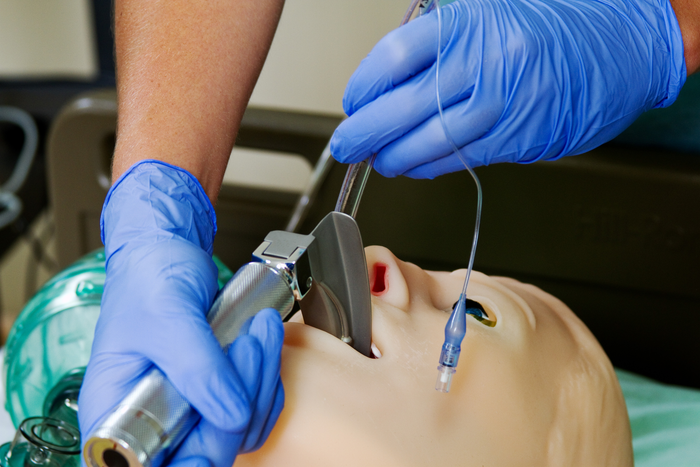
The patient has suffered a gunshot wound to the chest, and his blood pressure is dangerously low. You’ve covered the entry wound to prevent a sucking wound, but the patient is exhaling copious bloody froth. You successfully intubate the patient and are bagging, with good chest rise, but the bloody froth continues to interfere with air exchange. It’s time to suction the tube.
Suctioning the endotracheal tube is not something most rescuers do on a regular basis. In most cases, placing an endotracheal tube ensures a patent airway with little chance of aspiration. But in some situations, such as chest trauma or in patients with COPD, you can get mucus or blood invading the tube, necessitating suction.
But suctioning the tube is more complicated than simply suctioning the oral or nasal cavity. For one thing, it requires adequate negative pressure from a reliable portable suction unit. It also requires different equipment and special technique, and it poses specific dangers that oral/nasal suctioning does not. So let’s review the steps involved in suctioning the endotracheal tube.
Avoid Hypoxia
Before you begin the procedure, it is important to preoxygenate your patient. One of the greatest dangers of suctioning is hypoxia. By preoxygenating your patient with 100 percent 02 and avoiding prolonged suctioning, you reduce the risk of hypoxia and can maintain adequate oxygen saturation–from 95% to 100%.
Properly Prep Your Equipment
Just as in intubating, you should have all your equipment laid out next to the patient. Proper readiness will ensure the procedure goes smoothly and swiftly. The last thing you want is to be fumbling in the airway bag, looking for lubricant. Lay everything out for an easy grab.
Next, Follow These Steps
- Maintain universal precautions.
- Choose the appropriate-sized flexible catheter–one that will extend beyond the tip of the endotracheal tube.
- Use sterile technique when handling the catheter—remember, this is going INSIDE your patient!
- Lubricate the suction catheter for ease of insertion.
- Preoxygenate the patient for one to two minutes before suctioning.
- Insert the catheter without suction, then slowly withdraw while applying suction and rotating the catheter.
- Suction for no longer than 10 seconds to prevent hypoxia.
- Monitor the patient closely for signs of hypoxia (cardiac arrhythmias, drop in 02 sat).
- Reassess the airway, endotracheal tube, and lungs and continue ventilating.
- Repeat the suction procedure as necessary, but ensure reoxygenation between suction events.
Choosing the Right Suction Machine
Your choice of a portable suction machine will obviously be made prior to your need to suction the endotracheal tube. But you should consider such events when deciding on the type of unit for your agency. Here are a few considerations:
- Power: Choose a suction unit that offers adequate negative pressure, especially in the event of heavy mucus or clotted blood.
- Adjustable Pressure: Certain situations require you to dial back the pressure, and having a portable suction unit that enables this is a plus. These instances include
- Geriatric patients—who have delicate mucosal tissues that can tear easily and bleed.
- Pediatric patients—whose smaller oral and nasal cavities may require less negative pressure to prevent damage and hypoxia.
- Catheter Selection: Choose small, flexible catheters for endotracheal suctioning and a selection of hard-tipped catheters for oral and nasal suction.
When responding to chronic patients, you may be called upon to suction a permanent airway, such as a stoma. Once again, you must employ a sterile technique to avoid introducing contaminants. Use the same procedure you would when suctioning the endotracheal tube, only when you insert the catheter, advance until the patient coughs.
Potential Suctioning Complications
Endotracheal suctioning, like oral or nasal, poses complications for your patient. Here are some considerations:
- Hypoxia is always a risk during any type of suctioning
- Trauma to the airway tissues
- Cardiac arrhythmias—monitor the patient at all times
- Increased intracranial pressure—avoid prolonged suctioning
- Inability to clear mucus plug—repeat procedure until the airway is clear, but be sure to reoxygenate between suction attempts
Suctioning the endotracheal tube can pose a challenge, but it can be safely performed in the field. Ensure adequate oxygenation of your patient, use sterile and proper technique, and have the right equipment on hand. Having a portable suction machine that provides adequate negative pressure is critical, and one that can provide adjustable pressure can ensure that special populations (elderly patients and the very young) are taken care of.
Editor's Note: This blog was originally published in August, 2017. It has been re-published with additional up to date content.
















